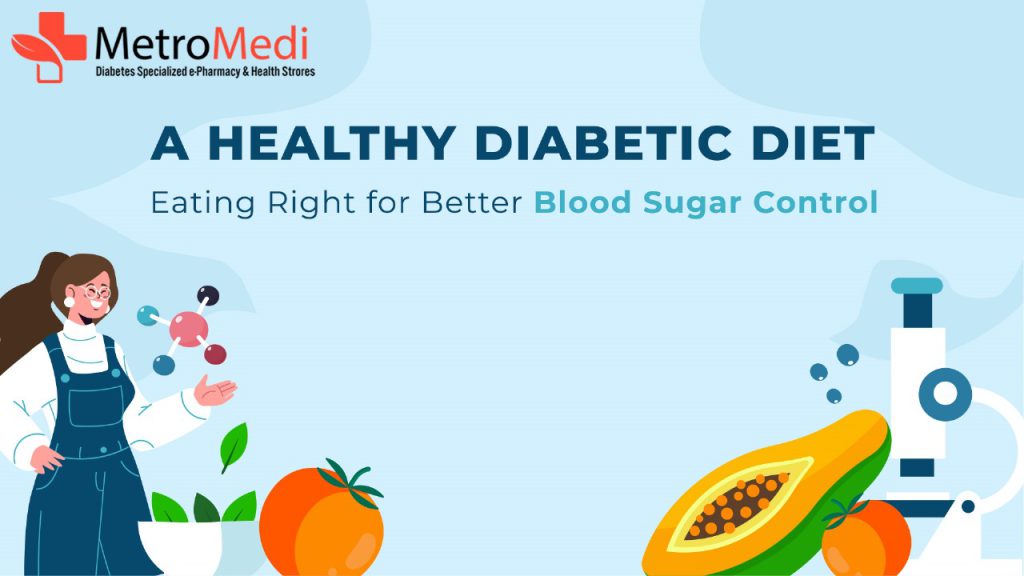
Managing diabetes involves making informed dietary choices that support stable blood sugar levels and overall health. A healthy diabetic diet doesn’t mean sacrificing flavour or enjoyment—it’s about finding the right balance of nutrients and foods that can help maintain energy levels and promote well-being. In this blog, we’ll explore the essentials of a healthy diabetic diet, including what to eat, what to avoid, and practical tips for meal planning.
1. Understanding Carbohydrates
Carbohydrates have a direct impact on blood sugar levels, so it’s crucial to understand which types to include in your diet. Focus on:
- Complex Carbohydrates: These are digested more slowly, leading to gradual increases in blood sugar. Sources include whole grains (brown rice, quinoa, whole-grain bread), legumes (beans, lentils), and starchy vegetables (sweet potatoes, peas).
- Fiber-Rich Foods: Fiber helps regulate blood sugar levels and improve gut health. Aim for plenty of fruits for diabetic patients, vegetables, whole grains, and legumes. Foods like apples, berries, broccoli, and chia seeds are excellent choices.
2. Incorporating Lean Proteins
Protein plays a vital role in keeping you full and helping manage blood sugar levels. Choose lean protein sources such as:
- Poultry: Skinless chicken and turkey are great options.
- Fish: Fatty fish like salmon, mackerel, and sardines are high in omega-3 fatty acids, which are beneficial for heart health.
- Plant-Based Proteins: Incorporate beans, lentils, tofu, and edamame for a healthy, vegetarian source of protein.
3. Healthy Fats Are Essential
Fats are an important part of a balanced diet, but choosing the right types is key. Opt for:
- Monounsaturated Fats: Found in avocados, olive oil, nuts, and seeds, these fats can help improve cholesterol levels and support heart health.
- Omega-3 Fatty Acids: These are found in fatty fish, flaxseeds, chia seeds, and walnuts, known for their anti-inflammatory properties.
4. Emphasizing Non-Starchy Vegetables
Non-starchy vegetables are low in calories and carbohydrates, making them ideal for a diabetic diet. Include a variety of colourful veggies in your meals, such as:
- Leafy Greens: Spinach, kale, and Swiss chard are packed with vitamins and minerals.
- Cruciferous Vegetables: Broccoli, cauliflower, and Brussels sprouts are high in fibre and nutrients.
- Other Options: Bell peppers, zucchini, and asparagus add flavour and texture without adding many carbs.
5. Choosing Fruits for Diabetics
Incorporating fruits into a diet for diabetic patients can provide essential vitamins and minerals while satisfying sweet cravings. Opt for low-glycaemic fruits that have less impact on blood sugar levels, such as:
- Berries: Strawberries, blueberries, and raspberries are high in antioxidants and fibre.
- Cherries: These have a low glycaemic index and can help reduce inflammation.
- Apples: High in fibre and vitamins, apples are a convenient snack option.
- Citrus Fruits: Oranges, grapefruits, and lemons are rich in vitamin C and low in sugar.
6. Hydration Matters
Staying hydrated is crucial for overall health. Water is the best choice, but you can also incorporate herbal teas and other low-calorie beverages. Limit sugary drinks and excessive caffeine, as they can lead to spikes in blood sugar levels.
7. Meal Planning Tips
Creating a healthy meal plan can simplify your dietary choices and help you stay on track. Here are some tips:
- Portion Control: Be mindful of portion sizes to help manage calorie and carbohydrate intake.
- Balanced Meals: Aim for a balance of carbohydrates, proteins, and fats at each meal. A good rule of thumb is to fill half your plate with non-starchy vegetables, one quarter with lean protein, and one quarter with complex carbohydrates.
- Snacking Wisely: Choose healthy snacks, such as nuts, Greek yogurt, or veggies with hummus, to keep blood sugar levels stable between meals.
Conclusion
A healthy diabetic diet is about making informed choices that support stable blood sugar levels while still enjoying a variety of delicious foods. By focusing on whole, nutrient-dense foods, incorporating lean proteins, healthy fats, and fruits for diabetics, and staying hydrated, you can effectively manage diabetes and promote overall health. Remember to consult with a registered dietitian or healthcare provider to tailor your dietary choices to your individual needs and preferences. With a little planning and mindfulness, you can enjoy a satisfying and healthful diet that supports your diabetes management journey.
